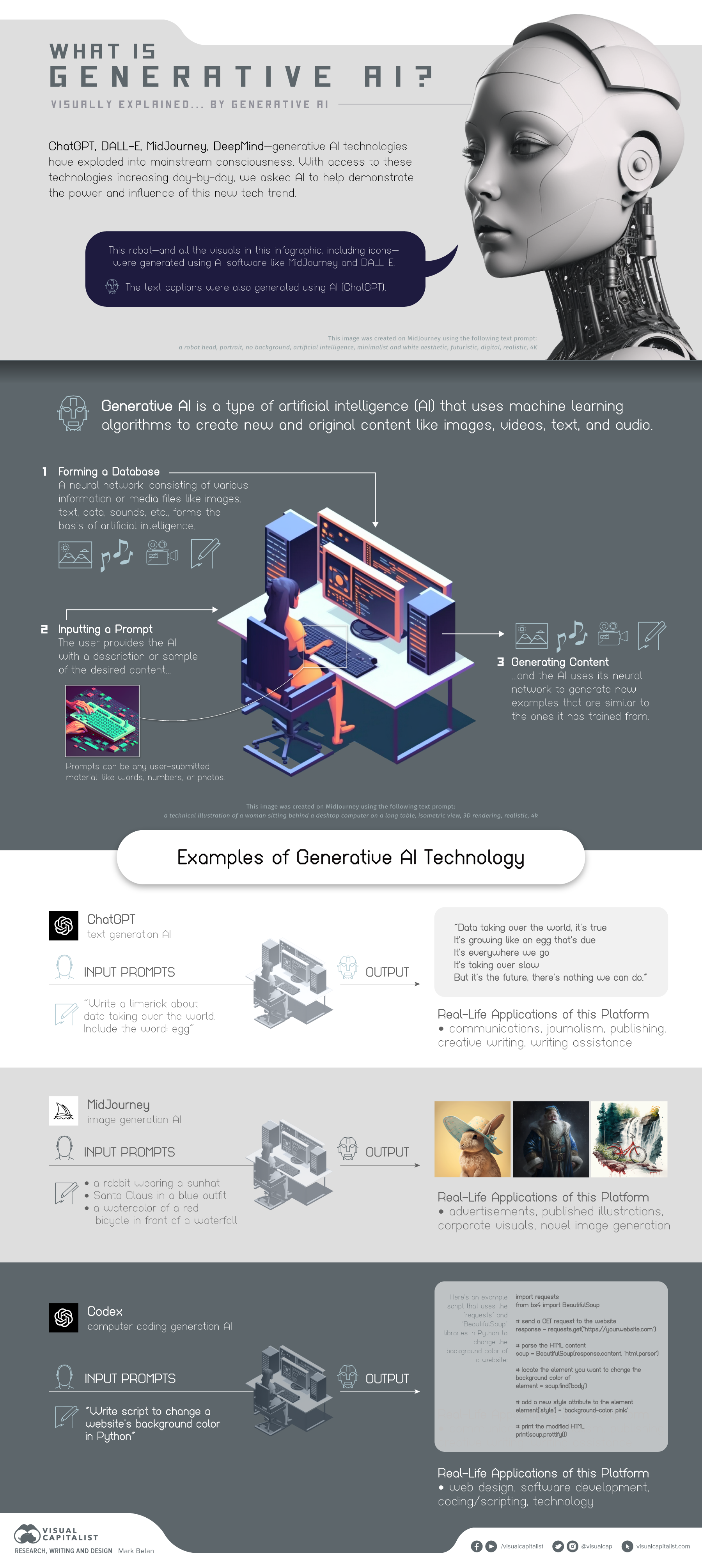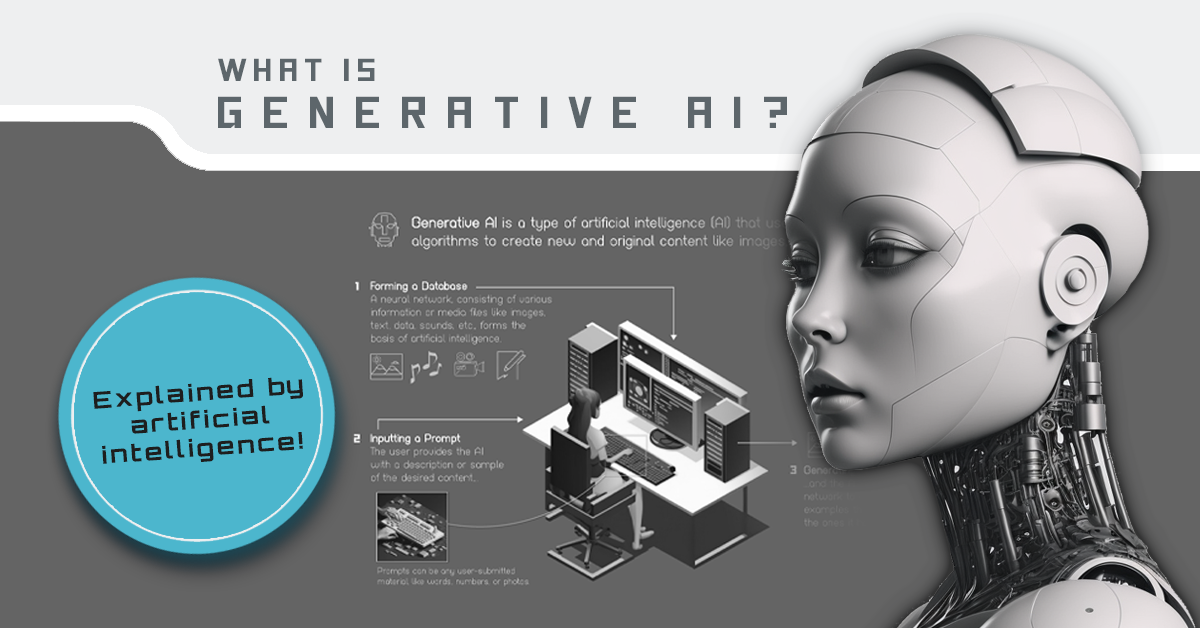Technology
Infographic: Generative AI Explained by AI

Generative AI Explained by AI
After years of research, it appears that artificial intelligence (AI) is reaching a sort of tipping point, capturing the imaginations of everyone from students saving time on their essay writing to leaders at the world’s largest tech companies. Excitement is building around the possibilities that AI tools unlock, but what exactly these tools are capable of and how they work is still not widely understood.
We could write about this in detail, but given how advanced tools like ChatGPT have become, it only seems right to see what generative AI has to say about itself.
Everything in the infographic above – from illustrations and icons to the text descriptions—was created using generative AI tools such as Midjourney. Everything that follows in this article was generated using ChatGPT based on specific prompts.
Without further ado, generative AI as explained by generative AI.
Generative AI: An Introduction
Generative AI refers to a category of artificial intelligence (AI) algorithms that generate new outputs based on the data they have been trained on. Unlike traditional AI systems that are designed to recognize patterns and make predictions, generative AI creates new content in the form of images, text, audio, and more.
Generative AI uses a type of deep learning called generative adversarial networks (GANs) to create new content. A GAN consists of two neural networks: a generator that creates new data and a discriminator that evaluates the data. The generator and discriminator work together, with the generator improving its outputs based on the feedback it receives from the discriminator until it generates content that is indistinguishable from real data.
Generative AI has a wide range of applications, including:
- Images: Generative AI can create new images based on existing ones, such as creating a new portrait based on a person’s face or a new landscape based on existing scenery
- Text: Generative AI can be used to write news articles, poetry, and even scripts. It can also be used to translate text from one language to another
- Audio: Generative AI can generate new music tracks, sound effects, and even voice acting
Disrupting Industries
People have concerns that generative AI and automation will lead to job displacement and unemployment, as machines become capable of performing tasks that were previously done by humans. They worry that the increasing use of AI will lead to a shrinking job market, particularly in industries such as manufacturing, customer service, and data entry.
Generative AI has the potential to disrupt several industries, including:
- Advertising: Generative AI can create new advertisements based on existing ones, making it easier for companies to reach new audiences
- Art and Design: Generative AI can help artists and designers create new works by generating new ideas and concepts
- Entertainment: Generative AI can create new video games, movies, and TV shows, making it easier for content creators to reach new audiences
Overall, while there are valid concerns about the impact of AI on the job market, there are also many potential benefits that could positively impact workers and the economy.
In the short term, generative AI tools can have positive impacts on the job market as well. For example, AI can automate repetitive and time-consuming tasks, and help humans make faster and more informed decisions by processing and analyzing large amounts of data. AI tools can free up time for humans to focus on more creative and value-adding work.
How This Article Was Created
This article was created using a language model AI trained by OpenAI. The AI was trained on a large dataset of text and was able to generate a new article based on the prompt given. In simple terms, the AI was fed information about what to write about and then generated the article based on that information.
In conclusion, generative AI is a powerful tool that has the potential to revolutionize several industries. With its ability to create new content based on existing data, generative AI has the potential to change the way we create and consume content in the future.
Technology
Charting the Next Generation of Internet
In this graphic, Visual Capitalist has partnered with MSCI to explore the potential of satellite internet as the next generation of internet innovation.

Could Tomorrow’s Internet be Streamed from Space?
In 2023, 2.6 billion people could not access the internet. Today, companies worldwide are looking to innovative technology to ensure more people are online at the speed of today’s technology.
Could satellite internet provide the solution?
In collaboration with MSCI, we embarked on a journey to explore whether tomorrow’s internet could be streamed from space.
Satellite Internet’s Potential Customer Base
Millions of people live in rural communities or mobile homes, and many spend much of their lives at sea or have no fixed abode. So, they cannot access the internet simply because the technology is unavailable.
Satellite internet gives these communities access to the internet without requiring a fixed location. Consequently, the volume of people who could get online using satellite internet is significant:
| Area | Potential Subscribers |
|---|---|
| Households Without Internet Access | 600,000,000 |
| RVs | 11,000,000 |
| Recreational Boats | 8,500,000 |
| Ships | 100,000 |
| Commercial Aircraft | 25,000 |
Advances in Satellite Technology
Satellite internet is not a new concept. However, it has only recently been that roadblocks around cost and long turnaround times have been overcome.
NASA’s space shuttle, until it was retired in 2011, was the only reusable means of transporting crew and cargo into orbit. It cost over $1.5 billion and took an average of 252 days to launch and refurbish.
In stark contrast, SpaceX’s Falcon 9 can now launch objects into orbit and maintain them at a fraction of the time and cost, less than 1% of the space shuttle’s cost.
| Average Rocket Turnaround Time | Average Launch/Refurbishment Cost | |
|---|---|---|
| Falcon 9* | 21 days | < $1,000,000 |
| Space Shuttle | 252 days | $1,500,000,000 (approximately) |
Satellites are now deployed 300 miles in low Earth orbit (LEO) rather than 22,000 miles above Earth in Geostationary Orbit (GEO), previously the typical satellite deployment altitude.
What this means for the consumer is that satellite internet streamed from LEO has a latency of 40 ms, which is an optimal internet connection. Especially when compared to the 700 ms stream latency experienced with satellite internet streamed from GEO.
What Would it Take to Build a Satellite Internet?
SpaceX, the private company that operates Starlink, currently has 4,500 satellites. However, the company believes it will require 10 times this number to provide comprehensive satellite internet coverage.
Charting the number of active satellites reveals that, despite the increasing number of active satellites, many more must be launched to create a comprehensive satellite internet.
| Year | Number of Active Satellites |
|---|---|
| 2022 | 6,905 |
| 2021 | 4,800 |
| 2020 | 3,256 |
| 2019 | 2,272 |
| 2018 | 2,027 |
| 2017 | 1,778 |
| 2016 | 1,462 |
| 2015 | 1,364 |
| 2014 | 1,262 |
| 2013 | 1,187 |
Next-Generation Internet Innovation
Innovation is at the heart of the internet’s next generation, and the MSCI Next Generation Innovation Index exposes investors to companies that can take advantage of potentially disruptive technologies like satellite internet.
You can gain exposure to companies advancing access to the internet with four indexes:
- MSCI ACWI IMI Next Generation Internet Innovation Index
- MSCI World IMI Next Generation Internet Innovation 30 Index
- MSCI China All Shares IMI Next Generation Internet Innovation Index
- MSCI China A Onshore IMI Next Generation Internet Innovation Index
MSCI thematic indexes are objective, rules-based, and regularly updated to focus on specific emerging trends that could evolve.

Click here to explore the MSCI thematic indexes

-

 Technology1 week ago
Technology1 week agoCountries With the Highest Rates of Crypto Ownership
While the U.S. is a major market for cryptocurrencies, two countries surpass it in terms of their rates of crypto ownership.
-

 Technology1 week ago
Technology1 week agoMapped: The Number of AI Startups By Country
Over the past decade, thousands of AI startups have been funded worldwide. See which countries are leading the charge in this map graphic.
-

 Technology3 weeks ago
Technology3 weeks agoAll of the Grants Given by the U.S. CHIPS Act
Intel, TSMC, and more have received billions in subsidies from the U.S. CHIPS Act in 2024.
-

 Technology3 weeks ago
Technology3 weeks agoVisualizing AI Patents by Country
See which countries have been granted the most AI patents each year, from 2012 to 2022.
-

 Technology3 weeks ago
Technology3 weeks agoHow Tech Logos Have Evolved Over Time
From complete overhauls to more subtle tweaks, these tech logos have had quite a journey. Featuring: Google, Apple, and more.
-

 AI1 month ago
AI1 month agoRanked: Semiconductor Companies by Industry Revenue Share
Nvidia is coming for Intel’s crown. Samsung is losing ground. AI is transforming the space. We break down revenue for semiconductor companies.
-

 Markets1 week ago
Markets1 week agoMapped: The Most Valuable Company in Each Southeast Asian Country
-

 Personal Finance6 days ago
Personal Finance6 days agoVisualizing the Tax Burden of Every U.S. State
-

 Mining7 days ago
Mining7 days agoWhere the World’s Aluminum is Smelted, by Country
-

 Technology1 week ago
Technology1 week agoCountries With the Highest Rates of Crypto Ownership
-

 Money1 week ago
Money1 week agoCharted: What Frustrates Americans About the Tax System
-

 Economy1 week ago
Economy1 week agoMapped: Europe’s GDP Per Capita, by Country
-

 Stocks1 week ago
Stocks1 week agoThe Growth of a $1,000 Equity Investment, by Stock Market
-

 Healthcare1 week ago
Healthcare1 week agoLife Expectancy by Region (1950-2050F)
















